This is an injury to the growth plate of the fibula bone of the lower leg.
Healing:
This normally takes approximately 4-6 weeks to heal.
Pain and swelling:
Your ankle may be swollen and painful. Swelling is often worse at the end of the day. It is normal to have mild pain and swelling for 3-6 months after your injury.
Taking pain medication and elevating your ankle will help. Raise your ankle on a stool or cushions so that it is above the level of your hip. This will help to reduce your swelling.
Walking and your boot:
You will be in a walking boot and you are allowed to put weight through your foot as much as you can tolerate for 4 weeks. You can use crutches to support you when walking if required. You can remove the boot at rest/at night if comfortable.
Follow up:
A follow up appointment is not normally needed for this injury. You will be referred to our Physiotherapy Team and will be contacted by them directly. Please contact the Virtual Fracture Clinic if after 4 weeks you still have significant pain or swelling.
Any questions: If you are concerned about your symptoms, are unable to follow this rehabilitation plan, or have pain other than at your ankle please contact the Virtual Fracture Clinic.
Caring for your injury: Week 1-4
Try to rest your ankle where possible, raise your ankle on a stool or cushions so that it is above the level of your hip. This will help to reduce your swelling.
Exercises:
It is important to exercise your ankle, knee, hip and bottom muscles of your injured leg to maintain as much muscle strength and encourage blood flow to prevent DVTs. You should also check you can move your toes regularly. Here are some examples:
Inner Range Quads Exercise
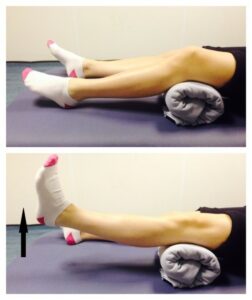
Place a rolled up towel or small pillow under your injured knee.
Tense your thigh muscle and try to straighten your knee. Keep the back of your knee in contact with the towel/pillow.
Repeat 10 times. If you can, try to hold your knee straight for 5 seconds.
Seated knee flexion and extension
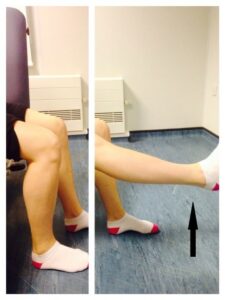
Sit on a chair or on the edge of your bed. Bend and straighten your knee, lifting your heel off the floor.
Repeat this 10 times.
If you can, try holding your knee straight for 5 seconds.
Do these exercises 3-4 times a day to improve movement at the ankle. Start straight away, you do not need to push into pain.
1. Point your foot up and down. Repeat this 10 times.
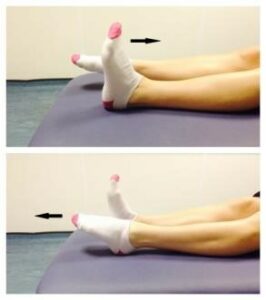
2. With your heels together, move your toes apart to turn the foot outwards. Repeat this 10 times. Do this movement gently within comfort.
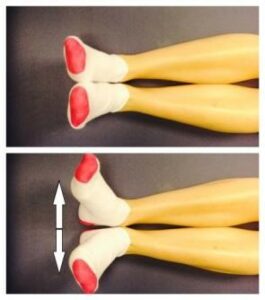
3. Make gentle circles with your foot in one direction and then the other direction. Repeat this 10 times.
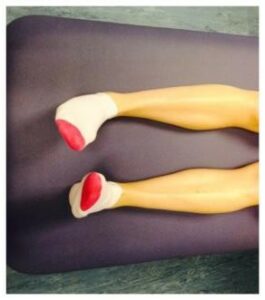
Caring for your injury: Week 4-12
You can now stop using your boot and crutches and start to fully bear weight. Start by walking without the boot around your own home. Build up to walking without it outside or for longer walks. You should not be using your boot or crutches after 6 weeks post injury.
It is normal to still have mild discomfort and swelling. However if you are still experiencing pain after 4 weeks please contact the Virtual Fracture Clinic.
You can now progress your exercises.
Stretches
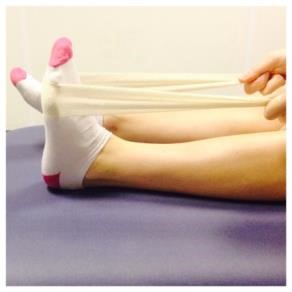
Sit with your leg straight out in front of you. Put a towel or bandage around your foot and pull it towards you. Feel a stretch in the back of the calf. Hold for 30 seconds.
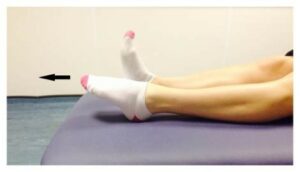
Point your toes down as far as they go, place your other foot on top and apply some pressure. This will stretch the top of your foot. Hold for 30 seconds.
Balance
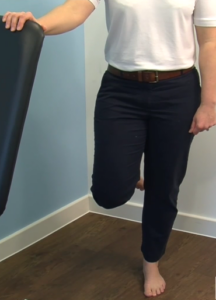
1. Hold onto a firm surface in a safe space. Try to stand on one leg. Hold this for 30 seconds. Stop if you experience pain. When you can do this comfortably, try the next exercise.
2. Try to stand on one leg without holding on to a support. Try to hold this for 30 seconds. When you can do this comfortably, try the next exercise.
3. You can try these exercises with your eyes closed. Make sure you are always in a safe environment with a support to hold if needed.
Activity and Exercise
Gradually increase your level of activity. If you are still having pain on walking, you should avoid impact activity, including running and jumping. If you have been referred to the Physiotherapy team, they can guide you on returning to any sports or impact activity.
Frequently Asked Questions
I’m concerned about my symptoms and/or I am struggling to return to exercise.
Please contact the Virtual Fracture Clinic.
What do I do with my boot and crutches when I no longer need them?
We are not able to use boots again. These should not be returned to the hospital.
Crutches can be returned to the Fracture Clinic or A&E.
I am struggling with my boot. What do I do?
The boot has a thicker sole; this can make you feel uneven. Make sure you wear a supportive shoe or trainer on your uninjured foot. This will reduce stress on other joints.
If you need more advice contact the Virtual Fracture Clinic.
Contact Details for Bedford and Luton
Please contact the hospital where you attended A&E as the other site will not be able to access your notes
BEDFORD HOSPITAL PATIENTS
How do I contact the Virtual Fracture Clinic (VFC)
- Telephone 01234 792036
- Messages will be checked every morning Monday to Friday (except for Bank Holidays)
- Email VFCBedford@bedfordhospital.nhs.uk
How do I contact the Fracture Clinic?
- Telephone 01234 792138
How do I contact the Plaster Room?
- Telephone 01234 792031
- Monday to Friday 9am to 5pm (out of hours contact the Emergency Department)
LUTON & DUNSTABLE HOSPITAL PATIENTS
How do I contact the Virtual Fracture Clinic (VFC)
- Telephone 01582 718121
- Messages will be checked every morning Monday to Friday (except for Bank Holidays)
- Email VFCLuton@ldh.nhs.uk
How do I contact the Fracture Clinic?
- Telephone 01582 497194 or 01582 718 993 (outpatient appointments)
How do I contact the Plaster Room?
- Telephone 01582 491166 (ext. 2233)
- Monday to Friday 9am to 5pm (out of hours contact the Emergency Department)
